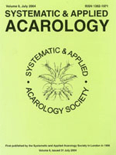
SYSTEMATIC AND APPLIED ACAROLOGY
Scope & Guideline
Elevating the science of mites and ticks for a sustainable future.
Introduction
Aims and Scopes
- Taxonomy and Systematics of Mites and Ticks:
The journal publishes original research articles that describe new species, genera, and families of mites and ticks, as well as revisions and keys that aid in the identification of known species. - Ecological and Behavioral Studies:
Papers often explore the ecological interactions of mites and ticks with their environments, including their roles as pests, predators, and parasites, as well as their behavior in various ecological contexts. - Mite and Tick Management:
Research on biological control methods, pesticide effects, and integrated pest management strategies for acarines is a key focus, providing practical solutions for agricultural and health-related mite and tick issues. - Phylogenetic and Molecular Studies:
The journal encourages articles that utilize molecular techniques, including DNA barcoding and phylogenetic analyses, to resolve taxonomic uncertainties and understand evolutionary relationships among acarine species. - Diversity and Faunistic Surveys:
Contributions that document the diversity of mites and ticks in various geographical regions and habitats are essential, highlighting the importance of understanding species distribution and conservation needs.
Trending and Emerging
- Integrative Taxonomy:
There is a growing trend towards integrative taxonomy, where researchers combine morphological, molecular, and ecological data to resolve taxonomic issues and better understand species boundaries among mites and ticks. - Ecological Impacts of Climate Change:
Research exploring how climate change affects mite and tick populations, distribution, and their interactions with hosts is gaining traction, reflecting concerns over biodiversity and ecosystem health. - Mite and Tick Pathogen Interactions:
Studies investigating the relationships between mites/ticks and their microbial communities, including symbiotic and pathogenic interactions, are emerging as a significant area of interest. - Conservation and Biodiversity Studies:
There is an increasing emphasis on documenting and conserving mite and tick biodiversity, with researchers focusing on faunistic surveys and the ecological roles of these organisms in various environments. - Use of Advanced Molecular Techniques:
The application of next-generation sequencing and other advanced molecular techniques to study the genetics and evolution of mites and ticks is on the rise, enhancing our understanding of their biodiversity and phylogenetics.
Declining or Waning
- Traditional Pest Control Studies:
There has been a noticeable decrease in research focused solely on chemical pest control methods without considering integrated approaches. This shift may stem from a growing awareness of the need for sustainable practices in agriculture. - Basic Morphological Studies:
While morphological descriptions remain important, there has been a decline in purely morphological studies without molecular or ecological context, as researchers increasingly adopt integrative approaches that combine multiple scientific disciplines. - Historical Taxonomic Reviews:
The publication of historical reviews or extensive taxonomic revisions seems to be waning in favor of more focused studies that address current ecological or management issues, reflecting a shift towards applied research.
Similar Journals

EXPERIMENTAL AND APPLIED ACAROLOGY
Innovating Acarology: Where Research Meets Real-World ImpactEXPERIMENTAL AND APPLIED ACAROLOGY is a leading international journal that serves as a premier platform for the dissemination of cutting-edge research in the fields of Ecology, Insect Science, and Medical applications related to acarology. Published by Springer, this esteemed journal has been pivotal in advancing our understanding of mite-related science since its inception in 1985, and it anticipates continued publication until 2024. With an impressive ranking in the Q2 quartile across multiple categories, including Ecology (Rank #154/461) and Insect Science (Rank #42/181), it firmly establishes itself as a significant contributor to the scientific community. Although not an Open Access journal, its rigorous peer-review process ensures high-quality publication standards, appealing to researchers, professionals, and students alike. Aiming to bridge gaps between experimental research and practical applications, EXPERIMENTAL AND APPLIED ACAROLOGY plays a crucial role in enhancing knowledge and discoveries related to acarology, highlighting its vital importance in ecology and health sciences.
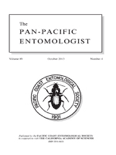
PAN-PACIFIC ENTOMOLOGIST
Connecting Research and Ecology Through InsectsPAN-PACIFIC ENTOMOLOGIST, published by the PACIFIC COAST ENTOMOLOGICAL SOCIETY, serves as a pivotal platform for disseminating research in the field of entomology, encompassing a variety of topics related to insects and their interactions within ecosystems. Operating under the ISSN 0031-0603 and E-ISSN 2162-0237, this esteemed journal has been committed to advancing our understanding of insect science since its initial publication in 1993, with coverage extending to 2024. Notably categorized in the Q4 quartile of the insect science category and ranked in the 5th percentile of Scopus, PAN-PACIFIC ENTOMOLOGIST offers a unique opportunity for scholars, professionals, and students to engage with cutting-edge research and contribute to the scientific dialogue within this specialized field. While currently not open access, the journal is dedicated to the dissemination of empirical studies, reviews, and short communications that elucidate the crucial roles insects play in agriculture, ecology, and public health. Situated in the heart of San Francisco, California, this journal not only enriches the academic community but also promotes a deeper appreciation for the diverse and often under-appreciated world of entomology.
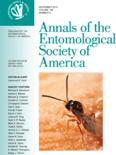
ANNALS OF THE ENTOMOLOGICAL SOCIETY OF AMERICA
Innovating Insights into the World of InsectsANNALS OF THE ENTOMOLOGICAL SOCIETY OF AMERICA is a premier journal dedicated to advancing the field of insect science, published by Oxford University Press. With an impressive impact factor and classified in the Q1 quartile for its category, this journal ranks among the top publications in agricultural and biological sciences, specifically within insect science, positioned at #28 out of 181, indicating its significant influence and high-quality research contributions. The journal aims to disseminate original research, comprehensive reviews, and groundbreaking findings that enhance our understanding of entomology, spanning across ecological, evolutionary, and applied segments. With a consistent publication history since 1938, researchers, professionals, and students will benefit from the wealth of knowledge presented in its pages. Although the journal does not currently offer open access, it remains a vital resource for those seeking to stay at the forefront of entomological research and innovation.

Journal of Insect Biodiversity
Diving Deep into Insect Diversity and BehaviorJournal of Insect Biodiversity, published by MAGNOLIA PRESS in New Zealand, offers a vital platform for researchers and professionals interested in the intricate world of insect science. Established in 2019, this journal covers a wide array of topics within its field, focusing on the ecological, evolutionary, and behavioral aspects of insects, while also engaging with paleontological perspectives. With an impressive Q2 and Q3 categorization in multiple ecological disciplines and a growing influence in the Scopus rankings, it serves as an essential resource for scholars aiming to deepen their understanding of insect diversity and its implications for ecosystems. The journal is committed to open access, promoting the dissemination of knowledge without barriers. Researchers, students, and professionals alike will benefit from the timely contributions this journal offers as it continues to reflect the dynamic and evolving nature of insect research up to the year 2024.

ACAROLOGIA
Bridging Fundamental and Applied Insect StudiesACAROLOGIA is an esteemed journal published by ACAROLOGIA-UNIVERSITE PAUL VALERY, specializing in the field of Insect Science. With an ISSN of 0044-586X and an e-ISSN of 2107-7207, this journal has been a pivotal resource for researchers and professionals since its inception in 1965. Located in Montpellier, France, it encompasses a broad scope of insect-related studies, contributing valuable insights into fundamental and applied entomology. The journal holds a prestigious position in the academic community, classified in the 2023 Q2 quartile of insect science, demonstrating its influence and relevance in the field. Furthermore, it ranks #86 out of 181 in Scopus’s Agricultural and Biological Sciences category, solidifying its standing among peer publications. Although it does not operate under an open access model, ACAROLOGIA remains a vital platform for disseminating innovative research from 1965 to the present, aspiring to foster a deeper understanding of insect biology and ecology. This journal serves not only as a repository of significant scientific findings but also as a catalyst for future studies and advancements in Insect Science.
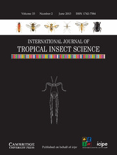
INTERNATIONAL JOURNAL OF TROPICAL INSECT SCIENCE
Uncovering the Secrets of Tropical Insect LifeINTERNATIONAL JOURNAL OF TROPICAL INSECT SCIENCE, published by Springer International Publishing AG, is a leading interdisciplinary journal dedicated to advancing knowledge in the fields of insect science and ecology. With its ISSN 1742-7584 and E-ISSN 1742-7592, this journal provides a platform for researchers to publish high-quality, peer-reviewed articles that explore various aspects of tropical insect biology, behavior, and their ecological impacts. As evidenced by its Q3 ranking in both Ecology, Evolution, Behavior and Systematics and Insect Science, it plays a vital role in fostering scientific dialogue and innovation within these disciplines. Researchers affiliated with the journal benefit from its visibility and growing impact, as demonstrated by its Scopus ranks, with a percentile standing of 61st in Insect Science. Although the journal is not open access, it still reaches a wide academic audience, making significant contributions to our understanding of tropical ecosystems. Situated in Switzerland, this journal is crucial for students, professionals, and researchers invested in the intersection of entomology and ecological science.
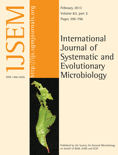
INTERNATIONAL JOURNAL OF SYSTEMATIC AND EVOLUTIONARY MICROBIOLOGY
Connecting Researchers to the Microbial FrontierInternational Journal of Systematic and Evolutionary Microbiology, published by the Microbiology Society, stands at the forefront of microbiological research, focusing on the systematic and evolutionary aspects of microorganisms. With its ISSN 1466-5026 and e-ISSN 1466-5034, this prestigious journal not only boasts an impressive impact within its fields—ranked Q1 in both Ecology, Evolution, Behavior and Systematics and Medicine (Miscellaneous), and Q2 in Microbiology for 2023—but also consistently provides an open access platform for researchers to disseminate their findings. Established in 2000, the journal has established itself as an essential resource for professionals and students alike, offering insights into microbial diversity, systematics, and evolutionary pathways. By providing a rich repository of knowledge with a global reach from its UK base, IJSEM continues to enhance our understanding of the microbial world, fostering collaboration and innovation in microbiological science.

REVISTA DE LA SOCIEDAD ENTOMOLOGICA ARGENTINA
Exploring the Wonders of Insect BiodiversityREVISTA DE LA SOCIEDAD ENTOMOLOGICA ARGENTINA is an esteemed open-access journal dedicated to the field of entomology, published by the SOCIEDAD ENTOMOLOGICA ARGENTINA. Since its transition to open access in 2013, the journal has sought to promote research in insect science, ecology, and related disciplines, facilitating global dissemination of knowledge and encouraging collaborative studies across borders. Located in the vibrant scientific landscape of La Plata, Argentina, the journal is indexed in Scopus and categorized in the fourth quartile of ecology and insect science, reflecting its commitment to enhancing the discourse within these critical fields. Aiming to bridge the gap between researchers, students, and professionals, REVISTA DE LA SOCIEDAD ENTOMOLOGICA ARGENTINA serves as a platform for innovative research, reviews, and reports on ecological interactions, behavior, and systematic entomology, ultimately driving forward our understanding of insect biodiversity and its broader environmental impacts.

SPIXIANA
Cultivating a Deeper Understanding of Zoological SciencesSPIXIANA is a distinguished journal dedicated to the fields of animal science and zoology, published by VERLAG DR FRIEDRICH PFEIL in Germany. With the ISSN 0341-8391, it has been contributing to the scientific community since its inception, with volumes converging from 2008 to 2024. Although currently listed in the Q4 quartile of the 2023 category rankings for Animal Science and Zoology, it provides a vital platform for researchers and professionals to disseminate significant findings in the field. Despite being unindexed in open access, SPIXIANA ensures that vital research reaches its audience, enhancing academic discourse and furthering our understanding of zoological sciences. Its commitment to sharing rigorous scientific research make it an important resource for anyone passionate about animal biology and conservation.
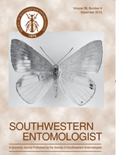
SOUTHWESTERN ENTOMOLOGIST
Bridging Research and Application in Southwestern EntomologySOUTHWESTERN ENTOMOLOGIST is a pivotal academic journal dedicated to advancing the fields of Agronomy, Ecology, and Insect Science. Published by the SOUTHWESTERN ENTOMOLOGICAL SOC in the United States, this journal plays a crucial role in disseminating vital research findings that address pressing ecological and agricultural challenges. With its ISSN 0147-1724 and E-ISSN 2162-2647, the journal has been publishing comprehensive studies since 1993 and continues to contribute significantly to the knowledge base up to 2024. As a Q4 ranked journal in both Agronomy and Crop Science and Ecology, as well as Insect Science, it provides an inclusive platform for researchers and students to share their insights and foster collaborations. Although it currently does not offer open access options, the content is accessible to academic institutions and professionals, ensuring that significant findings reach a broad audience. Given its niche focus, SOUTHWESTERN ENTOMOLOGIST not only appeals to researchers and students but also to professionals looking to stay updated on the latest trends and developments in entomology and its related fields.